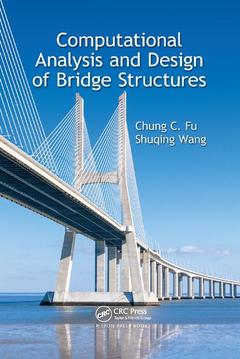Computational Analysis and Design of Bridge Structures
Auteurs : Fu Chung C., Wang Shuqing

Gain Confidence in Modeling Techniques Used for Complicated Bridge Structures
Bridge structures vary considerably in form, size, complexity, and importance. The methods for their computational analysis and design range from approximate to refined analyses, and rapidly improving computer technology has made the more refined and complex methods of analyses more commonplace. The key methods of analysis and related modeling techniques are set out, mainly for highway bridges, but also with some information on railway bridges. Special topics such as strut-and-tie modeling, linear and nonlinear buckling analysis, redundancy analysis, integral bridges, dynamic/earthquake analysis, and bridge geometry are also covered. The material is largely code independent. The book is written for students, especially at MSc level, and for practicing professionals in bridge design offices and bridge design authorities worldwide.
Effectively Analyze Structures Using Simple Mathematical Models
Divided into three parts and comprised of 18 chapters, this text:
- Covers the methods of computational analysis and design suitable for bridge structures
- Provides information on the methods of analysis and related modeling techniques suitable for the design and evaluation of various types of bridges
- Presents material on a wide range of bridge structural types and is fairly code independent
Computational Analysis and Design of Bridge Structures covers the general aspects of bridges, bridge behavior and the modeling of bridges, and special topics on bridges. This text explores the physical meanings behind modeling, and reveals how bridge structures can be analyzed using mathematical models.
Part I. General. Introduction. Approximate and refined analysis methods. Numerical methods in bridge structure analysis. Part II. Bridge behavior and modeling. Reinforced concrete bridges. Prestressed/post-tensioned concrete bridges. Curved concrete bridges. Straight and curved steel I-girder bridges. Straight and curved steel box girder bridges. Arch bridges. Steel truss bridges. Cable-stayed bridges. Suspension bridges. Part III. Special topics of bridges. Strut-and-tie modeling. Stability. Redundancy analysis. Integral bridges. Dynamic/earthquake analysis. Bridge geometry. References. Index.
Chung C. Fu, PhD, PE, FASCE, is research professor and bridge consultant, and director of the Bridge Engineering Software and Technology (BEST) Center at the University of Maryland, College Park, Maryland. His publications include 50 referred publications, 20 publications, more than 100 presentations and conference proceedings, and 50 public technical reports. His areas of expertise cover all types of structural engineering, bridge engineering, earthquake engineering, computer application in structures, finite element analysis, ultra high-performance concrete, steel and composite applications, including fiber-reinforced polymer and high-performance steel for innovative bridge research and construction, bridge management, testing (material and structural), and nondestructive evaluation applications.
Shuqing Wang
Date de parution : 07-2017
15.6x23.4 cm
Date de parution : 12-2014
Ouvrage de 631 p.
15.6x23.4 cm
Thèmes de Computational Analysis and Design of Bridge Structures :
Mots-clés :
Li Ne; Cable Stayed Bridge; live; Box Girder; load; Live Loads; box; Curved Box Girder; girder; AASHTO LRFD Specification; cable-stayed; Extreme Live Load; dead; Grillage Model; bending; Girder Segments; moment; Finite Element Model; truss; Live Load Distribution Factor; element; Cross Frames; Beam Slab Bridges; Box Girder Bridge; Live Load Analyses; Steel Box Girder; Main Span; Arch Bridge; Torsional Constant; AASHTO LRFD; Dead Loads; Beam Elements; Stiffened Girder; Integral Abutment; Truss Bridge



